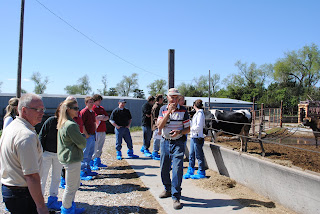 Adapting
to a fresh environment far from home takes a certain kind of fortitude.
Yesterday was my first day interning at the U.S. Grains Council and only my
second day in the District of Columbia.
Although I am just removed from four months abroad in Latin America,
D.C. is a different kind of beast; it is extremely easy to be intimidated by
the complexity of the situation. For example, the metro is the only legitimate
means of transportation for anyone non-local into the city, and the outlandish
cost of living forces subtle poor students like me to the margins of the
metropolitan area, thus making for a long commute. Not to mention, when all is
said and done I will be 7 months removed from home.
Adapting
to a fresh environment far from home takes a certain kind of fortitude.
Yesterday was my first day interning at the U.S. Grains Council and only my
second day in the District of Columbia.
Although I am just removed from four months abroad in Latin America,
D.C. is a different kind of beast; it is extremely easy to be intimidated by
the complexity of the situation. For example, the metro is the only legitimate
means of transportation for anyone non-local into the city, and the outlandish
cost of living forces subtle poor students like me to the margins of the
metropolitan area, thus making for a long commute. Not to mention, when all is
said and done I will be 7 months removed from home. May 30, 2012
My Capital Commencement
 Adapting
to a fresh environment far from home takes a certain kind of fortitude.
Yesterday was my first day interning at the U.S. Grains Council and only my
second day in the District of Columbia.
Although I am just removed from four months abroad in Latin America,
D.C. is a different kind of beast; it is extremely easy to be intimidated by
the complexity of the situation. For example, the metro is the only legitimate
means of transportation for anyone non-local into the city, and the outlandish
cost of living forces subtle poor students like me to the margins of the
metropolitan area, thus making for a long commute. Not to mention, when all is
said and done I will be 7 months removed from home.
Adapting
to a fresh environment far from home takes a certain kind of fortitude.
Yesterday was my first day interning at the U.S. Grains Council and only my
second day in the District of Columbia.
Although I am just removed from four months abroad in Latin America,
D.C. is a different kind of beast; it is extremely easy to be intimidated by
the complexity of the situation. For example, the metro is the only legitimate
means of transportation for anyone non-local into the city, and the outlandish
cost of living forces subtle poor students like me to the margins of the
metropolitan area, thus making for a long commute. Not to mention, when all is
said and done I will be 7 months removed from home. New interns broaden scope of Nebraska Corn Board programs
The new interns will be hosted by national cooperators of NCB: National Corn Growers Association (NCGA) in St. Louis, MO, the U.S. GrainsCouncil (USGC) in Washington, D.C. and the U.S. Meat Export Federation (USMEF) in Denver, CO. The internship program in the NCB office in Lincoln and the National Corn Growers Association intern in Washington, D.C. are programs that have been in place for several years.
 The NCB office in Lincoln welcomed Melisa Konecky of
Wahoo, Neb. for a year-long internship. Melisa will be a senior in animal
science and agriculture leadership at the University of Nebraska – Lincoln. As
part of her internship, she will oversee crop progress report placement,
contribute to communication and market development programs and help with
education and promotion activities.
The NCB office in Lincoln welcomed Melisa Konecky of
Wahoo, Neb. for a year-long internship. Melisa will be a senior in animal
science and agriculture leadership at the University of Nebraska – Lincoln. As
part of her internship, she will oversee crop progress report placement,
contribute to communication and market development programs and help with
education and promotion activities. The National Corn Growers Association office in
Washington, D.C. will host David Bresel of Lincoln, Neb., as their summer
intern supported by a partnership between NCB and NCGA. David is a student in
at the University of Nebraska College of Law. He will be involved with a variety of issues related to
environmental regulations, transportation, free trade agreements,
biotechnology, ethanol and energy.
The National Corn Growers Association office in
Washington, D.C. will host David Bresel of Lincoln, Neb., as their summer
intern supported by a partnership between NCB and NCGA. David is a student in
at the University of Nebraska College of Law. He will be involved with a variety of issues related to
environmental regulations, transportation, free trade agreements,
biotechnology, ethanol and energy. The National Corn Growers Association headquarters office
in St. Louis will host Sandra Kavan of Wahoo, Neb., as their first summer
intern supported by a partnership between NCB and NCGA. Sandra will be a senior
in agribusiness at the University of Nebraska – Lincoln. She will be assisting
with membership and communication programs, as well as participating in
committee meetings.
The National Corn Growers Association headquarters office
in St. Louis will host Sandra Kavan of Wahoo, Neb., as their first summer
intern supported by a partnership between NCB and NCGA. Sandra will be a senior
in agribusiness at the University of Nebraska – Lincoln. She will be assisting
with membership and communication programs, as well as participating in
committee meetings.  The U.S. Grains Council will host James Keating of
Ogallala, Neb., as their first summer intern supported by a partnership between
NCB and USGC. James is a senior in political science at the University of
Nebraska – Kearney. He will be working with policy, assisting with international
trade teams and helping to develop promotions and international relations.
The U.S. Grains Council will host James Keating of
Ogallala, Neb., as their first summer intern supported by a partnership between
NCB and USGC. James is a senior in political science at the University of
Nebraska – Kearney. He will be working with policy, assisting with international
trade teams and helping to develop promotions and international relations. The U.S. Meat Export Federation will host Jessica Clowser
of Seward, Neb., as their first summer intern supported by a partnership
between NCB and USMEF. Jessica graduated from the University of Nebraska-Lincoln in December 2011 with a B.S. in animal science and recently returned
from a semester internship with Nebraska Senator Mike Johanns in Washington,
D.C. In Denver, Jessica will
be assisting with promotions and international relationship opportunities.
The U.S. Meat Export Federation will host Jessica Clowser
of Seward, Neb., as their first summer intern supported by a partnership
between NCB and USMEF. Jessica graduated from the University of Nebraska-Lincoln in December 2011 with a B.S. in animal science and recently returned
from a semester internship with Nebraska Senator Mike Johanns in Washington,
D.C. In Denver, Jessica will
be assisting with promotions and international relationship opportunities.May 29, 2012
Summer Olympic Trials - by Curt Tomasevicz
Some sports like triathlon, shooting, and wrestling have just completed their Olympic team trials. They know who will be going to London and who will either retire or try again in four years. It’s sometimes easy to pick out those going to London by the look on their faces. It’s a combination of excitement, eagerness, and relief. Other athletes carry a look of discouragement because they simply fell short of their goal.
Some sports like track and field and swimming will have their trials in the next few weeks. These athletes are a little on edge and are extra cautious in everything they do. It would be horrible if they experienced some freak accident that would keep them out of their team trails. So they spend their time training and recovering with no extracurricular golfing or pickup basketball games. They take all precautions necessary to avoid getting sick at the wrong times. I urge all Nebraska farmers to take a few days out of the field and go to Omaha at the end of June to watch the swim trials and see the emotional effort by all the athletes. You’ll see what I mean. The swimmers’ effort and drive is contagious and inspirational.
Some see it as unavoidable, but I don’t like how some athletes can define their career as a success or a failure simply if they made an Olympic team or not. Yes, I’ll admit that the Olympics can change a person’s life in some ways but they cannot (and should not) change who a person is. My heart goes out to those athletes that don’t make their goal, but life is about setting a series of goals and going for the next one. Those that don’t make it should never use the word failure to describe their effort. There is success in learning the life lessons that come with competing in sports, especially at the highest level. It may take time to realize this, but there are more important things in life.
So as the next few weeks determine who will compete for the USA in London, I would like to congratulate all the athletes that gave their best effort to make their goals. To those that made it, I wish you the best and I know you’ll compete proudly for your country. To those athletes that may be forced to watch at home with the rest of us, I hope you hold your head high and know that by your effort, you’ve shaped your character to be the person you will be long after the London games have been forgotten.
Meet Nebraska Corn Board Director, Curt Friesen
 Curt Friesen represents District 3 for the Nebraska Corn Board and has been serving as a director on the board since 2008. He is also serving as the current secretary-treasurer of the board as well. Curt has over 35 years of experience operating and managing his farm near Henderson and is fourth generation farmer in Hamilton County. He and his wife, Nancy, raise white corn, yellow corn, and soybeans on irrigated land. They utilize gravity, pivot, and drip irrigation systems to increase yields while also conserving water that comes from the Ogallala aquifer.
Curt Friesen represents District 3 for the Nebraska Corn Board and has been serving as a director on the board since 2008. He is also serving as the current secretary-treasurer of the board as well. Curt has over 35 years of experience operating and managing his farm near Henderson and is fourth generation farmer in Hamilton County. He and his wife, Nancy, raise white corn, yellow corn, and soybeans on irrigated land. They utilize gravity, pivot, and drip irrigation systems to increase yields while also conserving water that comes from the Ogallala aquifer. May 28, 2012
Reaching Energy Independence
May 25, 2012
Podcast: RFS has done a lot to diversify fuel supply, reduce oil imports
 This podcast features Dan Wesely, a farmer from Morse Bluff and member of the Nebraska Corn Growers Association, discussing the Renewable Fuels Standard, or RFS.
This podcast features Dan Wesely, a farmer from Morse Bluff and member of the Nebraska Corn Growers Association, discussing the Renewable Fuels Standard, or RFS.The Energy Independence and Security Act became law five years ago, Wesely said. The act included an expanded Renewable Fuel Standard and built on the progress made by the 2005 Energy Policy Act, the first comprehensive energy legislation the nation saw in more than a decade.
"These energy independence acts are important, and the RFS is a key component and has done a lot to diversify our fuel supply and reduce oil imports," Wesley said. "In fact, the production and use of 13.9 billion gallons of ethanol last year helped reduce the need for imported oil by 485 million barrels. That saved us nearly $50 billion in oil imports."
He also noted that American-made ethanol contributed more volume to our fuel supply than the gasoline refined from oil imports from Saudi Arabia, Iraq and other OPEC nations.
May 24, 2012
Take a look at the corn nook
These new facilities will benefit all NCTA students and Nebraska agriculture as a whole, just as NCTA has benefited the state (and world) since it founding in 1968.
 The Nebraska Corn Board played a role in the
The Nebraska Corn Board played a role in the transformation of the NCTA campus by being the first major agriculture organization donor. In response, the Corn Board was allowed to leave its mark on a small area – nook – in the education center. The area will include tables and seating for students and visitors.
Highlighted by "theCORNer," the nook includes images of Nebraska farm families sharing some of the Nebraska Corn Board's Sustaining Innovation messages. The families represented and messages are designed to be changed out every few years to keep the area up-to-date.
On the additional wall are two hands (see below), with one handing a kernel of corn to the other. The line of text is "Raising The Bar For The Next Generation Of Nebraska Agriculture."
Click on any image to enlarge.
May 23, 2012
Corn messages 'delivered' to Berkshire Hathaway meeting
 Those making the annual pilgrimage to the Berkshire Hathaway annual meeting in Omaha earlier this month may have caught sight of a delivery truck wrapped with Sustaining Innovation messages.
Those making the annual pilgrimage to the Berkshire Hathaway annual meeting in Omaha earlier this month may have caught sight of a delivery truck wrapped with Sustaining Innovation messages.The truck is part of the Nebraska Corn Board's Sustaining Innovation program, which shares information about how corn farmers have an unwavering commitment to doing a better job in every row, on every acre, on every farm, every season. It’s how family corn farmers in Nebraska and the nation are ensuring the long-term viability of their industry and our natural resources.
There will be several trucks with different corn-related messages in Omaha this summer, and you may even spot one in Lincoln should the delivery route include a trip down I-80.
Another special event scheduled for a truck to "hang around" is the College World Series, which is scheduled to begin June 15 in downtown Omaha.
May 22, 2012
Video: E15 Expansion
With high gas prices, finding an alternative fuel option is always the goal and E15 fuel may be the future of gasoline.
E15 fuel is a blend of fifteen percent ethanol.
The Nebraska Corn Board recently met to discuss how to expand E15 fuel pumps.
The Corn Board says that they would like to see E15 introduced legally and safely and also said that there is a lot of misinformation about E15 such as requirements for ethanol plants and fuel retailers.
Last year, the EPA approved E15 for 2001 and newer cars, light-duty trucks, and SUVs.
Earlier this year, E15 became a legal fuel.
Thanks to KHAS-TV Channel 5 for this report.
May 21, 2012
Nebraska corn planting nearly complete; 78% of crop rated good to excellent
Corn emerged stood at 78 percent, up from 57 percent last week, 45 percent last year and the five-year average of 49 percent. The quick and early planting pace is evident here, as this year's crop is 29 points ahead of the average.
USDA this week began its corn condition numbers as part of the update. While early, it does give a good indication of the overall crop condition. As of yesterday, 78 percent of Nebraska's corn crop was rated good to excellent, while 20 percent was listed as fair and only 2 percent poor to very poor. Since this year's crop is earlier than last year, there are no numbers available for comparison's sake.
The first corn condition numbers last year came out on May 29...and then Nebraska's crop was rated 64 percent good to excellent, 33 percent average and 3 percent poor to very poor.
 |
| Corn planting this year compared to the five-year average. Click for a larger image. |
The national crop condition numbers were 77 percent good to excellent condition, 20 percent as fair and only 3 percent as poor to very poor.
You can follow updates on the 2012 corn crop here and at the Nebraska Corn Board's Crop Progress Update page. The Crop Progress Update page includes Nebraska corn facts and figures, photos of crop progress from FFA chapters and more. It's updated every two weeks from planting to harvest.
This week's photos come from the Nebraska Corn Board's 2012 crop progress photo set at Flickr. The top one was submitted by a member of the Imperial FFA Chapter and the one below came from the Heartland FFA Chapter.
May 19, 2012
Podcast: Great opportunity to serve as NeCGA intern
 This podcast features Shannon Wietjes, communications intern for the Nebraska Corn Growers Association since last fall.
This podcast features Shannon Wietjes, communications intern for the Nebraska Corn Growers Association since last fall.Wietjes talks about her experiences while at NeCGA, from sending out e-Newsletters to efforts in social media, including Facebook, Twitter and blogging. You can find her on Twitter at swietjes.
During her time at NeCGA, she had an opportunity to work with corn growers throughout Nebraska, attend many different events, from Husker Harvest Days to more locally-focused farm shows. She also attended the Nebraska Corn Growers Association leadership program in Washington, D.C.
For more, have a listen!
May 18, 2012
Ethanol saves you more than $1 per gallon
 America’s growing use of domestically-produced ethanol reduced wholesale gasoline prices by an average of $1.09 per gallon in 2011.
America’s growing use of domestically-produced ethanol reduced wholesale gasoline prices by an average of $1.09 per gallon in 2011.The updated research was conducted by economics professors at the University of Wisconsin and Iowa State University. The 2011 results, which are up from an average impact of $0.89 per gallon in 2010, were released today by the Center for Agricultural and Rural Development (CARD). The new analysis, an update to a 2009 peer-reviewed paper published in Energy Policy by professors Dermot Hayes and Xiaodong Du, also found gasoline prices have been reduced by an average of $0.29 per gallon, or 17%, from 2000-2011 thanks to the growing use of ethanol.
Three primary factors are responsible for ethanol’s more robust price benefit at the pump in 2011:
- Higher oil and gasoline prices
- Higher ethanol inclusion
- Ethanol being priced at a larger-than-normal discount to gasoline
Dinneen continued, “Because ethanol makes up 10% of our gasoline pool today, it significantly reduces demand for oil and puts downward pressure on gas prices. From coast to coast and border to border, ethanol is helping save consumers money. In these times of high unemployment and sky-high gas prices, ethanol is one America-made solution that is providing some respite for battered American families trying to make ends meet.”
Key conclusions derived from the report include:
- In 2011, ethanol reduced wholesale gasoline prices by an average of $1.09 per gallon.
- Regular grade gasoline prices averaged $3.52 per gallon in 2011, but would have been closer to $4.60 per gallon without the inclusion of more than 13 billion gallons of lower-priced ethanol.
- The average American household consumed 1,124 gallons of gasoline in 2011, meaning ethanol reduced average household spending at the pump by more than $1,200.
- Since 2000, ethanol has kept gasoline prices an average of $0.29 per gallon cheaper than they otherwise would have been.
- Based on the $0.29-per-gallon average annual savings, ethanol has helped save American drivers and the economy more than $477 billion in gasoline expenditures since 2000 – an average of $39.8 billion a year.
Read more about the above research here.
May 16, 2012
Corn planting on Alexander Cattle & Farms
Alexander Cattle & Farms in Nebraska is know for their beef. And many may know that JD Alexander is the President of the National Cattlemen’s Beef Association (NCBA). This is quite the accomplishment and we commend JD on this leadership role.
To get to know him a little better, and to celebrate May as Beef Month, the Nebraska Cattlemen have put together a great YouTube video series of JD and his farm titled, “Committed to Nebraska Beef”. We especially like the video about corn planting on the farm with Kory, farming lead, because after all – cattle love their corn!
Now go enjoy a Nebraska, corn-fed steak for Beef Month!
May 15, 2012
Corn Board sponsors tours of two Nebraska Dairies
 Last week the Nebraska Corn Board sponsored a dairy tour that the Midwest Dairy Association held for B&R Stores’ dairy case managers. The purpose of this tour was to give the managers a firsthand look at how milk ends up on their shelves that they in-turn sell to consumers.
Last week the Nebraska Corn Board sponsored a dairy tour that the Midwest Dairy Association held for B&R Stores’ dairy case managers. The purpose of this tour was to give the managers a firsthand look at how milk ends up on their shelves that they in-turn sell to consumers.The dairy industry is important to the corn industry as corn and distillers’ grains are fed to dairy cows. Five out of the six Dairy Case managers had never stepped foot on a dairy farm before. The tour allowed them to see the first stages of the milking process and how animals are treated with the best care.
 The first stop on the tour was at Ken Cast’s family dairy, Kendol Dairy, located near Beaver Crossing. His dairy includes two hundred Jersey milking cows with a few other breeds included in the mix. He currently works with his son who will eventually take over the family dairy. The Cast family milks their herd twice a day and sells most of their milk to DFA (Dairy Farmers of America), who then markets their milk to Robert’s.
The first stop on the tour was at Ken Cast’s family dairy, Kendol Dairy, located near Beaver Crossing. His dairy includes two hundred Jersey milking cows with a few other breeds included in the mix. He currently works with his son who will eventually take over the family dairy. The Cast family milks their herd twice a day and sells most of their milk to DFA (Dairy Farmers of America), who then markets their milk to Robert’s.Ken said that anytime their family has to use antibiotics to treat a sick animal, they won’t use the milk from that cow to protect the milk supply from getting contaminated with antibiotics. Ken also said that the dairy industry is one of the most regulated food industries in the nation and that inspectors at both the state and federal level will come to his farm to do random checks to be sure his family is providing a safe and nutritious product for consumers.
Many of the tour participants were amazed at how large the farm was, but at the same time, how clean everything was and how well the cows were being treated. The tour participants were also impressed with the technology that the farm uses to be more efficient with resources, and to make sure the cows are receiving the best care.
To learn more about how the Nebraska Corn Board works with the dairy industry, be sure to click here.
May 14, 2012
Nebraska corn planting wrapping up
 Farmers in Nebraska may mostly wrap up corn planting this week, as the U.S. Department of Agriculture said 91 percent of the state's crop is in the ground as of yesterday. That's well ahead of the five-year average of 76 percent planted by this date, which happens to be the same figure as last year's planting pace.
Farmers in Nebraska may mostly wrap up corn planting this week, as the U.S. Department of Agriculture said 91 percent of the state's crop is in the ground as of yesterday. That's well ahead of the five-year average of 76 percent planted by this date, which happens to be the same figure as last year's planting pace. As for emergence, USDA said 57 percent of the state's crop had emerged, up from last year's 16 percent emerged and the average of 23 percent by this date.
Nationally, USDA said 87 percent of the crop was planted, up from 71 percent last week, 56 percent last year and the five-year average of 66 percent.0
Nine of the top 10 producing corn states are more than 90 percent planted. The lone exception is Minnesota, which is 88 percent planted, up from 42 percent last year and the five-year average of 76 percent planted.
Emergence across the country reached 56 percent, up from 32 percent last week, 16 percent last year and 28 percent for the five-year average.
All of this, of course, bodes well for yields – at least most fields have the potential to yield big this year. A year ago so many farmers had to replant or plant late, yield potential had fallen before the corn even had a chance to get out of the ground.
This potential is why USDA last week (.pdf) reported that U.S. corn farmers are on pace to shatter production, yield and supply records this year. USDA's early estimate is for a record production of 14.8 billion bushels with record average yields of 166 bushels per acre (2.0 bushels above trend).
If realized, that would create a total corn supply of 15.7 billion bushels, 2.2 billion higher than in 2011 and, yes, a record.
Of course all of that is just an early estimate – it is only mid-May after all. There's a lot of weather between now and October.
Soreness is addicting - by Curt Tomasevicz
I started playing tackle football in 7th grade and I still remember how sore my scrawny neck was after the first day of practice from wearing an over-sized helmet. I must have looked like a bobble-head doll. Even as my muscles began to adapt to wearing the heavy equipment for the first time, my entire body was covered in bruises from the full-contact practices. I learned the importance of “icing” after practice and games.
As I grew older, I continued to abuse my body by playing football in the fall, basketball in the winter, and track in the spring. I remember waking up on Saturday mornings after high school football games and barely being able to roll out of bed. My bones were growing and so the pounding my knees and ankles endured during basketball and track took a toll and added to my cycles of soreness.
Soreness was probably at its peak when I played college football and spent two years as part of the scout team. I think the Blackshirts found a certain joy in punishing the scout team running back (me) play after play. I took (and delivered) some hits that caused my ears to hurt.
Eight years ago, after football, came bobsled. At times, on television, bobsled my look like a gentle sleigh ride on smooth ice, but it is anything but that! A fourteen-hundred pound sled going 90+ miles per hour doesn’t do anything gentle. As a brakeman, I’m in a vulnerable position that can often times cause joint adjustments each time we go down the track. The shaking and vibrating sled causes your head to rattle resulting in that same sore-neck feeling that I experienced fifteen years before in Jr.High football. Any person that has ever taken a real bobsled ride can attest that there is an inevitable soreness that will follow.
Throughout all the sports I have competed in, I also began to spend time in the weight room and, by pushing myself regularly, I found that I could be sore in places that I didn’t even know I had muscles. I found different exercises and lifts to do in the weightroom to increase strength, power, and speed. But with that, came a certain amount of pain. I’ve heard a saying that pain is just weakness leaving the body. But scientifically, when you strengthen muscles with resistance training, you are actually causing tiny tears in the muscle fibers. The pain and soreness that ensues is the body repairing and recovering from those tears. I’m sure every farmer knows how a sore back feels after a day of digging and putting in new fence posts. But after a day or two, as the tiny tears in the muscles recover, the soreness and discomfort goes away.
As crazy as it sounds, I think I’ve become addicted to that type of soreness. I’ve subconsciously taught myself that soreness is a sign of working hard. And hard work breeds success. Soreness is a way to measure gains in strength. If I am not sore after a long workout, I don’t feel that I pushed myself to the limit during that workout. This may not be a healthy approach to training, but I’ve found it is a way that I push myself daily in the off-season.
May and June are crucial months for bobsled training. It’s the time of the year that we can make great gains in strength and speed in the weightroom and on the running track. And although I spend almost as many hours trying to recover from soreness through massages, ice baths, sauna, and even yoga sessions, I know that I’ve become addicted to soreness and that’s what will make a successful bobsled season even more rewarding!
May 11, 2012
One Great Experience!
 It is hard to believe that it has been a year since I started interning with the Nebraska Corn Board and my time as an intern is about to come to an end. Words can’t even describe the type of experience I have had, which has ranged from learning about all the different issues facing corn farmers to seeing the opportunities that are available for future generations. It was also a great experience being able to serve over 23,000 Nebraska corn farmers who participate in the corn checkoff along with working for a great board and staff! For my last blog post on the Nebraska Corn Kernels, I would like to share with you some of the things I learned and also where I think the future of agriculture is heading.
It is hard to believe that it has been a year since I started interning with the Nebraska Corn Board and my time as an intern is about to come to an end. Words can’t even describe the type of experience I have had, which has ranged from learning about all the different issues facing corn farmers to seeing the opportunities that are available for future generations. It was also a great experience being able to serve over 23,000 Nebraska corn farmers who participate in the corn checkoff along with working for a great board and staff! For my last blog post on the Nebraska Corn Kernels, I would like to share with you some of the things I learned and also where I think the future of agriculture is heading. May 8, 2012
Videos: Prepping and planting corn
This first video shows him strip tilling – tilling a small row in corn stalk stubble where he'll plant this year's crop.
This video shows Jagels planting corn in a field that grew soybeans last year.
May 5, 2012
Podcast: Husker Food Connection great way to start a dialogue
 In this podcast, Lance Atwater, who has been an intern with the Nebraska Corn Board over the last year, provides some information and details on the Husker Food Connection.
In this podcast, Lance Atwater, who has been an intern with the Nebraska Corn Board over the last year, provides some information and details on the Husker Food Connection.Atwater (@latwater1) said Husker Food Connection took place on the University of Nebraska–Lincoln’s city campus.
"The purpose was to have students with ag backgrounds interact with non-ag students and explain and discuss where food comes from," he said. "It was also a good opportunity to put a face on all the farmers and ranchers students hear so much about."
He said this is important because most people are two or three generations removed from the farm. "They’ve never experienced agriculture and in some ways, how food ends up on the table is a mystery," he said.
To pull off the event, about 80 volunteers from the College of Agriculture and Natural Resources took time to work with their peers. For more details, click the icon above to listen to the podcast.
Or click here for a previous blog post.
May 4, 2012
Another Nebraska county designated Livestock Friendly
According to the Beatrice Daily Sun, the presentation was made during the annual "Day on the Farm" program.
"In receiving this designation, Gage County has made a strong commitment to supporting rural economic development," Sheehy said in a statement. "Being part of the Livestock Friendly program is a way to recognize the tremendous impact the livestock industry has on Main Street and the local economy. It provides jobs for those working with animals and a marketplace for grain and hay producers while also adding value to those products. With this designation, Gage County has demonstrated that it is open to agribusiness and the benefits that come from responsible livestock production."
The 14 other Livestock Friendly counties include Adams, Box Butte, Dawes, Deuel, Garden, Grant, Hitchcock, Jefferson, Keith, Lincoln, Morrill, Sheridan, Wayne and Webster Counties.
Greg Ibach, director of the Nebraska Department of Agriculture, said the official designation makes a positive statement about Gage County. "Gage County has a relatively large and dispersed population base. This designation shows that a county doesn’t have to choose between people and livestock," he said. "The county board has identified areas where agriculture and livestock can exist, prosper and grow, while still allowing room for people to enjoy country living."
To apply for a livestock friendly county designation, the county board must hold a public hearing and pass a resolution to apply. A completed application is then submitted to the Department of Agriculture for review.















